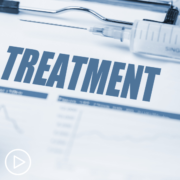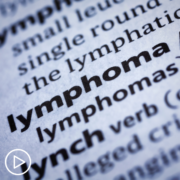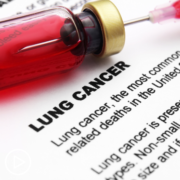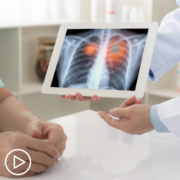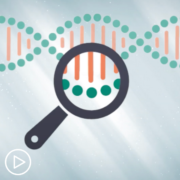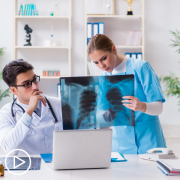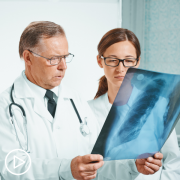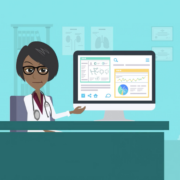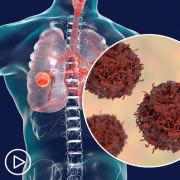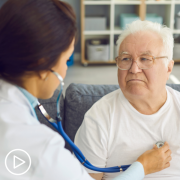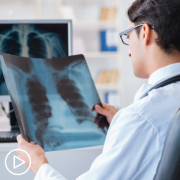Follicular Lymphoma Treatment Decisions: What’s Right for You? from Patient Empowerment Network on Vimeo.
When considering therapy for follicular lymphoma, what determines the best treatment for YOU? Dr. Tycel Phillips reviews key factors for making treatment decisions, tips for partnering with your healthcare team, and shares an update on emerging treatment and research.
Dr. Tycel Jovelle Phillips is a Medical Oncologist in the Hematology Clinic at The University of Michigan Rogel Cancer Center.
See More from The Pro-Active Follicular Lymphoma Patient Toolkit
Download Guide
Related Programs:
Transcript:
Katherine:
Hello and welcome. I’m Katherine Banwell, your host for today’s webinar. In this program, we’re going to learn more about follicular lymphoma. What it is, how it’s treated, and we’ll share tools to help you work with your healthcare team to access the best care. Before we meet our guest, let’s review a few important details. The reminder email you received about this program contains a link to program materials.
If you haven’t already, click that link to access information to follow along during the webinar. At the end of this program, you’ll receive a link to a program survey. Please take a moment to provide feedback about your experience today in order to help us plan future webinars. And finally, before we get into the discussion, please remember that this program is not a substitute for seeking medical advice. Please refer to your healthcare team about what might be best for you. Joining me today is Dr. Tycel Phillips. Welcome, Dr. Phillips. Would you please introduce yourself?
Dr. Phillips:
Hi, I’m Dr. Tycel Phillips. I’m an associate professor at the University of Michigan. I look forward to talking today.
Katherine:
Good. Thank you so much for taking the time out of your schedule. Before we learn about follicular lymphoma, let’s start with a question we’ve received that’s on the minds of many patients. Is the COVID vaccine safe and effective for follicular lymphoma patients?
Dr. Phillips:
So, the vaccine is safe. The effectiveness of the vaccine does in some part depend on whether the patients are untreated or they’re currently on treatment. Some of the treatments that we use to combat follicular lymphoma and other lymphomas unfortunately targets one of the key cells in the response to the vaccine. So, as follicular lymphoma is a cancer of the malignant B-cell, one of our treatments are directed, you know, obviously killing off malignant B-cells. And unfortunately, we do take some innocent bystanders. So, your normal B-cells will be impacted, which does sometimes impact your abilities to make antibodies.
But we do know from research that the vaccines will also trigger a T-cell response, which most of our treatments will not impact. So, well, we do recommend for our patients to be vaccinated. Because, again, it is safe. And, again, it is effective even if it’s not as effective as it would be if you weren’t on treatment.
Katherine:
Mm-hmm. Better to be safe than sorry.
Dr. Phillips:
Yes.
Katherine:
Let’s start at the very beginning. What exactly is follicular lymphoma?
Dr. Phillips:
So, follicular lymphoma is a malignant growth or tumor in some situations, depending on how you want to describe it, of lymphocytes. Lymphocytes are normal cells that we have in our body and are a very important part of our immune system. For a very generic sort of description, lymphocytes come in what we call B and T cells. B cells, as I mentioned, are the cells that help make antibodies and it’s how we fight viruses and other diseases. These antibodies help our immune system recognize and hopefully clear these pathogens quicker.
And then we also have T cells, which I like to refer to as like jailers, who will survey and sort of try to eliminate any abnormal cells. Lymphoma can come in a B-cell lymphoma or a T-cell lymphoma. For western Europe and the U.S., B-cell lymphomas account for the vast majority of cases of lymphoma; about 85 percent. When we look at B-cell lymphomas, we have Hodgkin’s Lymphomas, which are a separate category, and non-Hodgkin’s lymphomas.
And follicular lymphoma is the most common indolent, or what we consider slow growing, of non-Hodgkin’s lymphomas. So, when we talk about indolent as slow growing, these are lymphomas that are more than likely to be found incidentally by CAT scans. Or if you’re going for some other procedure, they’ll notice that you have enlarged lymph nodes and a biopsy will lead to a diagnosis of follicular lymphoma. In most cases, the cancer has probably been there for several years, at least months, before it’s been found. And in most cases, most patients have been living happily unbeknownst to them together with this cancer.
And so, follicular lymphoma being in that way is something that, again, we consider to be slow growing because, again, the more aggressive lymphomas tend to come with symptoms. So, these can come on more insidiously and are typically found incidentally.
Katherine:
You’ve touched upon this briefly, but what are the stages of follicular lymphoma? How does it progress?
Dr. Phillips:
So, when we talk about follicular lymphoma, so, in stages there are four stages. Stage I, which means it’s localized in one general area. Or potentially into one organ. Stage II means that it is on one side of the diaphragm. So, we use your diaphragm as sort of a dividing point. Sort of like a Mason-Dixon line of the body. So, if it’s all on one side, it’s a stage II. If you have disease both above and below the diaphragm, you’d be considered to be stage III. Stage IV indicates that you either have an organ involved in a nonadjacent lymph node.
So, let’s just say there’s a spot in your liver and you have a lymph node in your neck, or if your bone marrow is involved. For the most part, most patients with follicular lymphoma, because again, when develops, it doesn’t really develop with symptoms and typically is in there for quite a bit of time. Most patients will have what we consider to be advanced stage of this disease, meaning it’s stage III or IV. Because the cancer has quite a bit of time to grow and move around before we find it.
It also comes in a set of grades. So, stage and grades are different. Stage is location, grade is what the pathologist sort of looks at when he looks under a microscope – how angry or big the cells look. So, we typically divide it into grades 1 and 2; it’s very hard to separate one and two, so it’s generally grouped together. Which means there are mostly small round cells and very few big cells. And then we have grade 3A and grade 3B. And grade 3A means that when they look at it under the microscope, they see a fair number of larger cells which means that’s probably a bit more aggressive than the grade 1 to 2.
And grade 3B is sort of separated into a category of its own. And we tend to treat grade 3B as a more aggressive lymphoma. we treat that very closely, like we treat the diffuse large B-cell lymphomas. So, grade 3B is in a category of its own, and then grades 1 to 2 and grade 3 are sort of clumped together.
Katherine:
Okay. That’s very helpful, thank you. Now that we know more about follicular lymphoma and how it’s staged, let’s move on to treatment approaches. Many factors come into play, right, when making a treatment decision. Including a patient’s age and overall health. So, let’s walk through these considerations. How about we begin with treatment goals? What does this mean exactly and what are the goals of treatment for follicular lymphoma?
Dr. Phillips:
So, for the vast majority of patients, follicular lymphoma unfortunately to date is not curable. So, for those patients the goal of treatment when we initiate treatment is to alleviate any symptoms that may be caused by the lymphoma.
So, the patient has fevers, they have night sweats, or there’s some sort of organ damage from the cancer, our goal of treatment is to reverse that and put the cancer into what we call a remission. Remission basically means that from the test that we have currently, we cannot find any evidence of the cancer. That does not mean that you’re cured from the cancer. Patients with earlier stages – so, if you have a patient with stage I or a localized stage II, we approach that with a little bit of a different treatment mindset.
So, if we can catch it early enough, which is very hard given because of the cancer. So, these are really incidentally found, and in some cases, by luck. We can potentially cure follicular lymphoma in these patients. But that’s more of a curative intent with radiation and not systemic therapy. With the advent of PET scans, which have made it a little bit easier to find all the hidden areas of where the follicular lymphoma may hide out, concurrently with a bone marrow biopsy, if a patient is truly stage I, we will initiate therapy with a curative intent.
Whereas, again, with the other patients, our goal is just to control the symptoms and put you into remission.
Katherine:
What is considered when choosing a treatment? Are there test results that can impact the options?
Dr. Phillips:
So, there are. So, for the most part we’ll take a couple of things into consideration. So, there is no standard of care for follicular lymphomas. So, there are a couple different options that can be utilized in the upfront setting for the untreated patient. So, comorbidities play a part in what sort of treatment we choose. Patient’s age and fitness will play a part. If there’s any heart disease, that will play a part in the situation as well. And also, as I said, stage will play a part in sort of what our treatment goals are.
So, if our treatment goal for a really unfit patient who we don’t think can tolerate chemotherapy, it’s just symptom control. And they don’t have a lot of disease, we can sometimes treat them with just a monoclonal antibody we call rituximab (Rituxan) as a single agent.
If the patient has a lot of disease, and they are a fit patient, we will tend to combine rituximab with several different chemotherapy regimens. Because rituximab plus chemotherapy works better than chemotherapy and also rituximab alone, especially depending on the amount of the disease that we’re trying to treat. And again, as I mentioned before, if it’s a localized patient there is known to be radiation plus or minus rituximab in that situation.
But because of some of the side effects of the drugs we use, and obviously now we’re in a pandemic, a lot of those will take sort of some of the consideration of what we use. Some of the drugs that we use are either more sort of immunosuppressants than others, and obviously being in a pandemic, we have to take that into consideration because we’re not treating to cure. Some of the drugs can cause heart damage, some of the drugs can damage nerves, some of the drugs include steroids, which might be prohibited with some patients. So, all that sometimes has to be taken into consideration when we choose our regimen.
Katherine:
Yeah. It sounds like there are a lot of factors coming into play here.
Dr. Phillips:
Yeah, I mean normally, without a pandemic there’s a lot of factors, and the pandemic just makes things a little bit harder. Just because, again, our patients are already at risk based with some of the treatments we choose.
Katherine:
Yeah. Yeah. It’s pretty challenging right now. Does treatment typically start right away?
Dr. Phillips:
So, that really depends on a stage and also whether we meet certain sort of criteria to treat. So, we don’t have to treat right away. So, if a patient has a disease, and the disease is not in an area where we think it’s curative, for the most part we can enter into what we call a watch and wait. Meaning we will observe a patient very closely and defer treatment until the patient develops symptoms or other indications that warrant treatment.
We do know that there is no impact on longevity by sort of partaking in this approach. So, you won’t live any longer or you won’t live any shorter if we watch and wait versus initiating therapy right away. It just saves you from having some of the toxicities from treatment without any real major benefits.
So, remember the goal for most patients with follicular lymphoma is to alleviate symptoms or problems. If you don’t have a symptom or a problem, me giving you treatment is not going to make you feel any better. Actually, it would probably make you feel a little bit worse. To get you back to where you were when you started.
Katherine:
Yeah, right. What do you feel is the patient’s role in treatment decisions?
Dr. Phillips:
So, I know historically a lot of times, you come into an office, and we tell you what you’re going to get and what you’re not going to get. Patients nowadays are I would say a lot more savvy as far as what drugs are out there. And there are a lot more sort of conversational groups on social media between patients who’ve had treatment before and newly diagnosed patients. So, patients come in with a lot more information than they had historically had before. So, in that point, I think it’s more of an open dialogue about what options we have, what options are best for you, and what our treatment goals are at that point.
But all it means, given that we don’t yet have a standard of care, it leaves it open for discussion about sort of which route we choose to try to get your cancer under control.
Katherine:
Mm-hmm. Dr. Phillips, if a patient isn’t feeling confident with their treatment plan or their care, do you think they should consider a second opinion or a consult with a specialist?
Dr. Phillips:
I think a second opinion is probably best for all patients. It’s always probably good to get a different opinion about how the disease will be treated. So, I do encourage all my patients, even here, to get a second opinion. Some take me up on it, others won’t. But the option is always there to get a second opinion, just to see if anybody would do things any differently.
And I would say for the most part, most people would tend to treat the same way. Very seldom do we have differences in what our treatment recommendations would be. I think the biggest difference in some situations, it’s really about some patients are very uncomfortable being watched with an active cancer. And so, in that situation, that’s probably the biggest discrepancy we have nowadays.
Because of the anxiety of the watch and wait approach. Some patients would like treatment right away, irrespective of whether they need it or not. So, you’ll sometimes get discrepancies with our patients about that.
Katherine:
Mm-hmm. What would you say to a patient who may be nervous about offending their current doctor by getting a second opinion?
Dr. Phillips:
You shouldn’t be. If your doctor is offended because you’re getting a second opinion, that’s probably not the doctor for you. Yeah, I think that at this point, any physician that’s confident in their decision they’re giving you should not be offended if you go seek reassurance from somebody else.
Katherine:
Yeah, good advice. Thank you. Now that we’ve discussed factors that can impact treatment decisions, would you walk us through the currently available follicular lymphoma treatment approaches? And who they might be right for?
Dr. Phillips:
Sure. So, we’ll start with the newly diagnosed or untreated patient. So, again, if you’re newly diagnosed or untreated, your options are the monoclonal antibody, Rituximab. Again, that’s a CD20 monoclonal antibody.
That is typically given once weekly for four weeks and can be repeated, if need be, after a break. And that’s usually reserved for patients who have minimal symptoms, low burden disease. Because, again, data has shown that the bulkier the disease, you’re likely not to have a very durable or deep response with just simulating Rituximab. Additional options include Rituximab plus chemotherapy.
So, we have regimens such as CDP, which is Cytoxan, vincristine, and prednisone. Cytoxan and vincristine being a steroid, prednisone being — sorry, Cytoxan and vincristine being a chemotherapy agent, and prednisone being a steroid. We have our bendamustine, bendamustine being a chemotherapy agent. There’s R-CHOP, which is Cytoxan, vincristine, Adriamycin, and prednisone. And sometimes that is reserved, because unlike the other two, R-CHOP can only be given once because of the accumulation of the anthracycline.
You can only have so much of that in a lifetime before you run a risk of cardiac toxicity.
Katherine:
Oh.
Dr. Phillips:
And also, R-CHOP as of right now is a standard of care for diffuse large B-cell lymphoma. Which every patient with follicular lymphoma has a chance of transforming into diffuse large B-cell lymphoma at some point. So, we tend to try to reserve R-CHOP if we can. Additionally, more recently, there was a study called Relevance, which evaluated RPMO versus an agent called lenalidomide plus Rituximab, what we call R squared.
So, it was designed as a superiority study, but what came out of it is R squared is probably equivalent, not better, than R chemo. So that is also an option up front. With lenalidomide it’s a little bit different than the other agents, which all give it intravenously, meaning through the vein. But lenalidomide is an oral medication, that you would take 21 days on, and seven days off. And that’s given in conjunction with the Rituximab. And you typically would take that for 12 cycles, or about a year of treatment.
Whereas the chemotherapy regimens that I mentioned before, are typically given for six cycles. Meaning you’ll be taking it for a duration of 18 weeks or 24 weeks. So around four and half to six months for the chemotherapy. Thereafter, it’s a bit controversial, but some patients can then transition to what we call Rituximab maintenance.
Where you would get Rituximab every other month for a period of two to three years. Typically, two years, as a way to delay the return of the cancer. So, R maintenance we know of improves your progression of survival, so the time until the cancer comes back. And there is no survival benefit with maintenance at this point. So, it is in some ways a bit controversial. Especially now, given the pandemic.
Katherine:
What about stem cell transplant? Is that an option?
Dr. Phillips:
So, for up front, that’s usually not something that we typically do. So, for stem cell transplantation, there are two types of stem cell transplantation. There’s one called an Autologous Stem Cell Transplantation, which is basically really a stem cell rescue.
You get a high dose of chemotherapy after stem cells are collected from you and those stem cells are given back to rescue your body from the chemo. That is typically reserved for what we call high risk patients. So, we give you an initial up front chemotherapy regimen. And if your cancer comes back within less than 24 months of completion of that therapy, you fall into what we call a POD24 category. Which means Progression of Disease within 24 months.
We do know those patients are at higher risk, than patients who stay in remission for at least 24 months or longer. So, if we look at overall survival for those POD24 patients, about half of those patients will succumb to their disease within a five-year period. Which is much different for what we see with the standard for follicular lymphoma patients. So, and that POD24 category it does appear that Autologous Stem Cell Transplantation is beneficial in that patient population. As well as an Allogenic Stem Cell Transplant. So, an allogenic transplant is when you get immune cells from another donor.
So, “allo” meaning from a different person. So, in that sense, you get sort of temporized, and they would give you donor lymphocytes. And those lymphocytes themselves would try to fight off your cancer. So, an Auto transplant is mainly just chemo; an Allo transplant, the donor cells help fight off the cancer.
Katherine:
Right.
Dr. Phillips:
There are complications to both, which is why they’re not typically given up front. The Allo transplant probably has more risk of complications as well. Those cells can also recognize your body as being foreign and try to fight them off because they don’t originate from you. And there’s also just a risk of other death from that procedure. So, all those have to be taken with a bit of caution. And for the Allo transplant, it’s generally only recommended if you have that, a sibling donor. Because there’s much less risk of complications than versus you get an unrelated donor.
Katherine:
Right. Right, that makes sense. If someone receives treatment and then goes into remission, how are they monitored?
Dr. Phillips:
So, there’s a couple of different ways you can go about it.
Historically, what we would do is we would actually sometimes get CAT scans. But we’ve sort of pulled back from that in recent years. So, as of right now, the recommendation is really just clinical observation, meaning what I call well baby visits. Meaning I will see you in clinic at least every three months for the first year after completion of therapy. We do a system assessment, we’ll do a physical exam, we’ll do labs. Unless there is really something that at the completion of therapy that I’m concerned about, we won’t typically do any imaging.
We reserve imaging until there is a concern at some point, whether you have symptoms, there’s a lab issue, or there’s some other finding that comes up that means that we have to repeat pictures. So those visits I’ll do typically every three months for the first year, spaced out that every four months for the second year, post treatment. And then every six months up until about year four. And then it’ll become a yearly visit thereafter, as long as you continue to remain well without symptoms and nothing on an exam that’s concerning.
Katherine:
Yeah. We received this question from an audience member prior to the program. Angela asks, “What if I relapse after treatment? What are my options then?”
Dr. Phillips:
So, a lot of that, again, depends on the timing. If you relapse early, obviously whatever we gave you in the frontline we would not repeat. And again, if it’s within the 24-month period, again, that takes you on the road of POD24. Wherein patients who are fit enough, it would take you to a route where you would actually probably get a transplant. It’s consolidation to extend our true progression sabbatical.
If you relapse after 24 months, that would really depend on what you received in the frontline because some of these agents can be repeated. If we don’t repeat what you’ve had in a frontline setting – so again, if you’ve got R chemo, then a second line setting, normally what we would do now, based on published data from the augment study, is we would typically treat these patients with Rituximab and lenalidomide, which is that oral medication.
That’s typically if you did receive lenalidomide in the frontline setting and you would not want to repeat that, then we would typically give you R chemo in a second line setting. Again, in most of those situations, it would be RCP or Bendamustine and Rituximab.
Katherine:
Okay. Are there emerging approaches for treating follicular lymphoma that patients should know about?
Dr. Phillips:
There are. So, there are some more exciting data that’s coming out, specifically looking at CAR-T, which is chimeric antigen receptor therapy. So, these are augmented T cells that they collect from the patient, they help recognize – they help to modify those cancer cells to recognize the tumor more appropriately. And they target those tumor cells through a receptor called CD19 that’s present on the tumor.
So, that therapy has shown a significant overall response rate in follicular lymphoma. Even in very heavily pretreated patients. Right now, we’re still waiting on a longer follow up as far as the duration of the response, but as of right now it is a very encouraging therapy.
The downside to that therapy is that you can only receive it at select centers because they have to be a therapeutic approved center. So, you can’t just go sometimes to your regular oncologist’s in say, Skoboken or wherever, and get this treatment. So that’s one downside to that and also, it’s a very expensive treatment and you need insurance approval to cover that. Some of the side effects from that treatment we have gotten better at controlling, such as cytokine release syndrome, which can cause fever, low blood pressures, difficulty breathing.
That typically happens within a set period of time after the infusion of the [inaudible] and modified T cells. And then there’s also what we call neurotoxicity, meaning you can have some neurological complications. Which, again, we’ve become better at managing. There are a couple CAR-T products on the market right now; all of them seem very comparable and also effective in follicular lymphoma. There’s also treatments called bispecific antibodies, these are like causally off the shelf products, except they use an antibody.
And in this antibody it has sort of two receptors. So, earlier we talked about Rituximab, which is a CD20 antibody. The bispecifics have a CD20 antibody and a CD3 antibody set. So, they bind to the tumor and also bind to your T cells. And with the binding to the T-cells, they call it T-cell activation and expansion. And it will utilize your own T cells to fight off the cancer. So, because these bispecifics are given as an off the shelf product, they can likely be able to be given in more accessible areas.
So, you won’t have to select centers to be given. There are still some complications with those, such as CRS and neurotoxicity, but early reports indicate that they’re much less severe and less frequency than what we see with CAR-T. But as of right now, neither the duration of responses of these treatments are still to be determined. So, again, these are two exciting sort of avenues that are moving forward for patients with follicular lymphoma that will be further developed and sort of be expanded on in the coming years.
Katherine:
What about clinical trials? How do they fit in?
Dr. Phillips:
So, for patients with relapsed refractory disease and even some patients with untreated disease, clinical trials are sometimes your best avenue for getting some of these new and promising therapeutics before they get approval. I know sometimes patients are very cautious about clinical trials because they don’t want to be guinea pigs. But I would say all treatments that we offer you have started in clinical trials. And this is the only way to really advance the field. So, if your treating physician has a clinical trial for you, I would strongly recommend patients consider that.
Because, again, they are typically offering you something that they can’t offer you as a standard care, insurance approved treatment. And for the most part, they’re either adding drugs to what we do as far as standard of care treatment approach or offer you something that is very promising in the relapsed refractory setting or upfront setting. That compares very favorably to what we would give you as a standard of care option. That allows you to get this option sooner and earlier when you’re in better shape and less sort of beat up from the other treatments that we would give you.
Katherine:
I’d like to just go back for a second and ask you about inhibitor treatments.
Dr. Phillips:
Sure. So, as of right now, CAR-T with the chimeric antigen receptor therapy treatment is only approved for patients with relapsed refractory disease. The bispecific antibody therapies are only available in clinical trial. There are some other sort of cyclin inhibitors that haven’t gotten approval. So, we have the PO3 kind of Delta inhibitors, which inhibit the PO3 kind of pathway in a patient with follicular lymphoma.
There were four approved agents in this class of drugs. We had umbralisib, duvelisib, copanlisib, and idelalisib. More recently, two of those, idelalisib and duvelisib, have removed their indications for follicular lymphoma.
So, as of right now we have copanlisib which is an IDP kind of three dose inhibitor and umbralisib, which is an oral agent for the PO3 dose kind of inhibitor. So, both of those agents are typically usually targeted in the third line and beyond. So, patients who fail at least two lines of therapy. We also have tazemetostat, which is an EZH2 inhibitor, that was most recently improved. So, EZH2 mutations occur in about 20% of patients for follicular lymphoma.
But tazemetostat was actually approved for those with and without the mutation as it did show some efficacy in both. It appeared that the overall response rate was a bit higher than those who had an EZH2 mutation, with the duration of the response appears to be equivalent. But I do think for most parts in that situation, for those who lack the mutation the drug is typically used for patients who are unfit for other therapies. Whereas those who have the mutation, it typically probably will be used a bit earlier.
Katherine:
Okay. Excellent. Let’s take a moment to talk about patient self-advocacy. Patients can sometimes feel like they’re bothering their healthcare team with their questions and their comments. Why is it important for patients to speak up when it comes to symptoms and side effects?
Dr. Phillips:
Well, for the side effect part it’s important because your physician can’t potentially prevent the worst thing or further development of side effects. Nobody can. And also, they can’t prevent you from going to the hospital if you don’t let them know you have this certain side effects.
So, it’s very important to communicate side effects, because for the most part there are logical next steps that we can implement to either eliminate the side effects or hopefully prevent them from future treatment regimens. And also, other concerns that you may have. I mean, you only get one life. And this is your body. Then for the best part, it’s best to communicate any concerns that you may have in regard to treatment, or any questions you may have so that you are well aware.
You can’t really fight this appropriately without sort of being well aware of what you’re dealing with, what we’re using to take care of the cancer, and what potential side effects may come up. Again, so we can, again, have you have the best experience possible to try to get your cancer under control. I try to explain to my patients, “I don’t want you to wait until the next visit if you have issues.” I mean, we need to sort of manage these in real time. Even things we don’t take care of right then and there, again, it gives us a heads up and a head start to try to take care of these problems the next time you come to the clinic.
Katherine:
Dr. Phillips, to close, what would you like to leave the audience with? Are you hopeful?
Dr. Phillips:
So, I think follicular lymphoma, and lymphoma in general, we are having a better understanding of the biology of the cancer, certain things that are important to the cancer, and certain avenues that we can treat the cancer and avoid some toxicities that have sort of plagued us before. So, I think moving forward there is a ton of research going into improving outcomes for patients with lymphoma, and follicular lymphoma, in general. There are a ton of other treatment options that are coming down the pipe way.
So, I think patients with follicular lymphoma should be very hopeful and encouraged that we will just continue to improve the quality of life and also the duration that they can live with this cancer. I mean, as of right now, until we can cure this cancer, our real goal is to continue to buy you more time. And time buys you more treatments. And most of the treatments that we are developing and are coming, again, down the pipeline are less toxic than some of the things we had 5, 10, definitely 15, 20 years ago.
So, your experience and your quality of life will be improved, and these treatments will also give you more longevity than you could have ever expected. So, patients with lymphoma are living a lot longer and that’s not an important thing to remember. Not hopeful, not – sorry, it’s not hopeless, even though we may say we can’t cure your cancer, the goal is as of right now is to turn this into a chronic disease such as any other chronic disease. Something that you can live with, while managing control. Hopefully, you will continue to enjoy your life and your life won’t be cut short by this cancer.
Katherine:
Dr. Phillips, thanks so much for joining us today. We really appreciate it.
Dr. Phillips:
No, thank you. I really enjoyed it.
Katherine:
And thank you to all of our partners. Please continue to send in your questions to question@powerfulpatients.org. and we’ll work to get them answered in future programs. If you would like to watch this webinar again, there will be a replay available soon. You’ll received an email when it’s ready.
And don’t forget to take the survey immediately following this webinar. It will help us as we plan future programs. To learn more about follicular lymphoma, and to access tools to help you become a more proactive patient, visit powerfulpatients.org. I’m Katherine Banwell. Thanks for being with us today.

